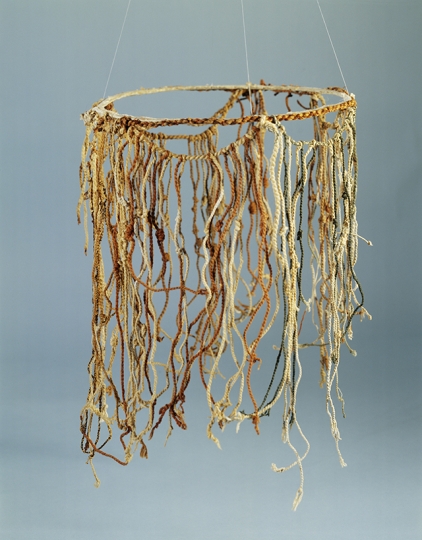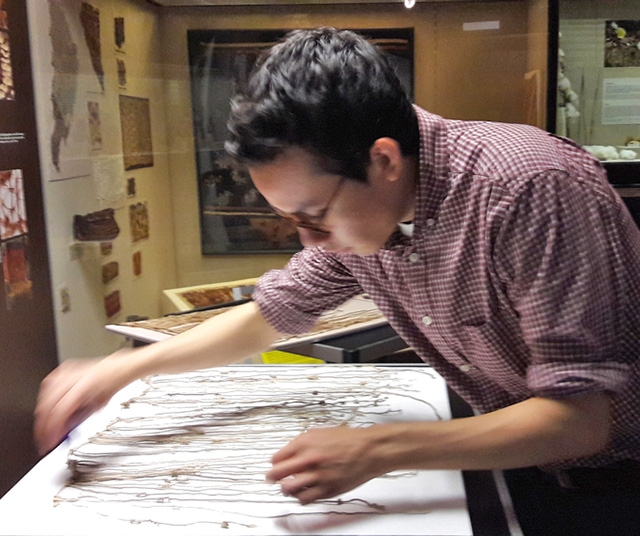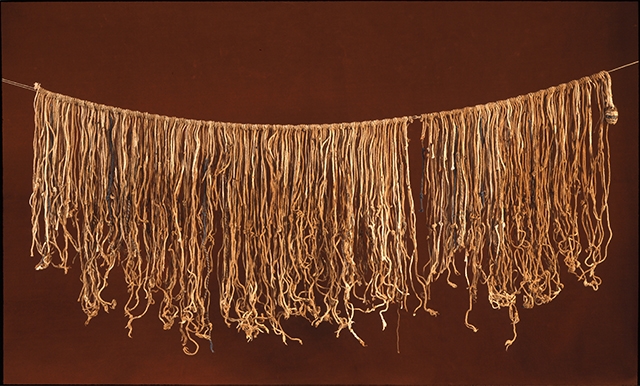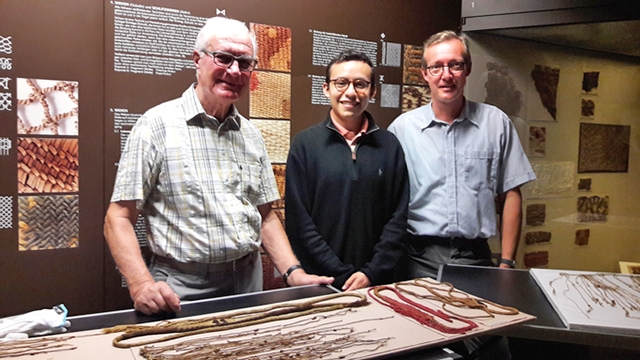News
In 1783, a group of Andean villagers met in secret to plan a revolt against the Spanish colonialists who had destroyed the once great Inca Empire. They encoded messages about the uprising onto two khipus, knotted cord devices used for Inca record keeping.
Tipped off about the plan, Spanish officials thwarted the uprising, tried the participants, and executed the leader of the revolt, which was relegated to a historical footnote as civil unrest spread across Latin America.
This Incan khipu, made from cords of yarn, is from the collection of the Peabody Museum of Archaeology and Ethnology at Harvard University. (Gift of Alfred M. Tozzer, 1941 © President and Fellows of Harvard College, Peabody Museum of Archaeology and Ethnology, PM# 41-52-30/2938)
More than 235 years later, Sabine Hyland, an anthropology professor at the University of St. Andrews in Scotland, uncovered those khipus in the village of San Juan de Collata in the Peruvian highlands.
Now, with the aid of a Harvard John A. Paulson School of Engineering and Applied Sciences student, these two khipus could help researchers finally decode the ancient language of the Incas. Researchers believe the written testimony from that 1783 trial (more than 1,000 pages) contains messages that could be encoded onto those khipus.
Manny Medrano, A.B. ’19, the recipient of a prestigious Marshall Scholarship who will pursue Ph.D. studies with Hyland at St. Andrews, will use his quantitative training to parse matches between the handwritten Spanish testimonies and the colored khipu cords.
“The primary sources of an entire continent remain right in front of us, but at the same time, they are opaque. It is as if our own Declaration of Independence was sitting there, but in a language we couldn’t read,” said Medrano, an applied math concentrator. “These are the original documents that helped administer an empire of more than 10 million people, yet we still can’t read them.”
Only about 1,000 khipus still exist and deciphering them is, at its core, a computational linguistics problem, Medrano explained. After the conquest of the Inca Empire, Spanish administrators often compelled local khipu readers to narrate their cords, and Spanish scribes transcribed the dialect into Old Castilian, line by line and cord by cord.
Medrano hopes to build a “plagiarism checker” that could identify patterns between written texts.
“When undergrads turn in papers, there are online tools based in linear algebra that compare the text in the paper to papers that have been submitted by other undergrads and also what is on the internet,” he said. “I want to do the same thing with 16th century documents. If we can find significant overlap between these khipu transcriptions, we can start to identify patterns in Castilian word order and sentence structure, and see if those patterns can be grafted onto the full body of numerical khipu data to see if there is a match sitting right in front of us.”
Many challenges arise from working with documents and artifacts that are more than 400 years old.
Medrano studies a khipu at the Lippisches Landesmuseum during a research trip to Detmold, Germany. (Photo courtesy of Manny Medrano.)
For instance, after the colonial period began in Latin America, there was huge variation in how khipus were used, and color lacked a unified meaning among the different regions of the former Inca Empire.
“Stoplights work because drivers know that green means go and red means stop. But with this set of khipus, it is as if drivers got to choose what each color meant,” he said. “So we’ve got hundreds of cords on these two khipus from the village of San Juan de Collata that have a huge diversity of color, but we lack a full understanding of whether red means warfare or dark blue means water. We just don’t have that baseline.”
Medrano plans to tackle that problem using advanced pattern identification techniques, to determine which color each khipu producer assigned to a certain term or syllable.
Incomplete information makes these problems even more complex. The only khipus that have survived are nearly all from the coastal regions of Peru and Chile, where drier air prevented the animal fiber cords from disintegrating.
As time and the elements continue to wear away at this unreadable language, Medrano feels a sense of urgency. He cited a devastating fire at the Brazilian National Museum in 2018 that wiped out the entire linguistics collection, including recordings of the last speakers of extinct Amazonian languages.
Recovered in the Nazca Province in Peru, this khipu incorporates multicolored fibers. (Gift of Robert Woods Bliss, 1942 © President and Fellows of Harvard College, Peabody Museum of Archaeology and Ethnology, PM# 42-28-30/4532)
“You don’t miss the water until the well runs dry,” he said. “We have these 1,000 khipus that are gathering dust in museum archives, and they don’t make headlines especially often. So we don’t miss them until, God forbid, some of them are lost in a fire.”
As he races against time, his personal connection to Latin America drives his passion for this intricate research.
Medrano’s grandparents immigrated to the U.S. from Mexico, and their struggles with language and literacy led to a great deal of discrimination while they were working hard to build better lives for their families.
“The Inca Empire is often described in academic literature as an illiterate nation. That hits close to home. They are often described as having been one of the most advanced civilizations of the ancient world, despite not having discovered graphical writing. That ‘despite’ clause is what I am trying to combat,” he said. “I’m constantly bothered by the fact that we qualify the achievements of Latin American peoples with this trope of illiteracy by saying they were innovative, without having stumbled upon the wonders of modern Western civilization.”
Medrano’s enthusiasm for his work also stems from his lifelong love of the ancient past. The Los Angeles native recalls visiting a traveling exhibition of objects from the tomb of King Tut as a first grader, and being amazed that objects dating back thousands of years were sitting behind the glass.
He enjoyed math in high school, and chose an applied math concentration at SEAS so he could tackle quandaries from disparate fields that aren’t traditionally thought of as math problems.
Looking to broaden his horizons outside of a quantitative context, he took a course on the Inca Empire taught by Gary Urton, Dumbarton Oaks Professor of Pre-Columbian Studies, during his freshman year. Medrano immediately began working with Urton as a research assistant, combining his love of archaeology with his interest in complex math. He was intrigued by the quantitative challenges involved in deciphering khipus, and co-authored a paper with Urton in 2018 that discussed the connection between six colonial period, Inca-style khipus and a Spanish census document.
Medrano with Michael Zelle, Director of the Lippisches Landesmuseum in Detmold, Germany (right), and Roger Meyer, who works with the museum's Peruvian collections. (Photo courtesy of Manny Medrano)
He’s looking forward to continuing his studies of these unpublished documents on an even larger scale at St. Andrews, building off momentum that has been growing since that paper’s publication.
Medrano has received many messages from people lauding his work, from professors who are incorporating khipus into their coursework, to a North Dakota artist whose latest project is inspired by khipus, to indigenous Peruvians who express thanks that he is keeping their cultural heritage alive.
As he digs in for years of hard work ahead, Medrano has his sights set on the future while his feet are firmly planted in the past.
“This work compels you to put yourself in the shoes of someone who lived hundreds of years ago,” he said. “The number of people who have read these unpublished documents since the 1500s can probably be counted on one hand. Since I’m the one reading these now, there is a sense that I can do something with them. If I put them down and move on, it might be another 200 years before someone else looks at this piece of paper again.”
Topics: Applied Mathematics
Cutting-edge science delivered direct to your inbox.
Join the Harvard SEAS mailing list.






